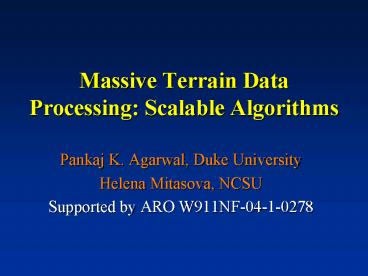Massive Terrain Data Processing: Scalable Algorithms PowerPoint PPT Presentation
1 / 33
Title: Massive Terrain Data Processing: Scalable Algorithms
1
Massive Terrain Data Processing Scalable
Algorithms
- Pankaj K. Agarwal, Duke University
- Helena Mitasova, NCSU
- Supported by ARO W911NF-04-1-0278
2
STREAM Project
http//terrain.cs.duke.edu/
- Scalable Techniques for hi-Resolution Elevation
data Analysis Modeling - Participants (PIs)
- Pankaj K. Agarwal
- Lars Arge
- Helena Mitasova
Students Andrew Danner Thomas Molhave Amber
Stillings Ke Yi
3
Massive Data Sets
- LIDAR point clouds
- late 90ies NC Coast 200 million points over 7
GB - Neuse River basin (NC) 500 million points over
17 GB - Raster DEMs are also large
- 3m res. grid 3 billion cells
- Data too big for RAM
- Must reside on disk
- Disk is slow
4
Increasing LIDAR point density
NC Coast from 1pt/3m to 1pt/0.3m substantially
improved representation of structures but much
larger data sets
1m resolution DEM computed by RST
binned
computed by RST 2004 lidar 0.5m resolution DEM
5
Terrain modeling and analysis workflow
r.in.xyz
r.what, awk
v.in.ascii -b, v.surf.rst
6
Terrain modeling and analysis workflow
r.terraflow
r.watershed.pfst?
7
Elevation points to TIN DEM
- TIN Triangulated Irregular Network
Constrained DelaunayTriangulation Developed an
I/O-efficient algorithm requires special vector
data structure, stand alone module
8
Construction of grid DEM
Modified I/O efficient approach
- Segment the space into small regions
- Interpolate within each segment, any
interpolation/approximation method can be used - Evaluate at grid cells, write grid cell values as
(i,j,z) as they are computed - Sort grid cells by raster order
9
Coping with Noisy Data
- vegetation, natural roughness, lidar errors
noise (bumps and pits) - in high resolution DEMs - difficulties extracting
topo features - smoothing during DEM construction (e.g. using
RST) reduces noise and allows to extract some
curvature based features
tension 700
tension 100
profile curvature slope
z-deviations, vegetation
10
Analysis of systematic error
Often overlooked step in terrain
analysis Elevation difference between RTK-GPS
survey (0.03m RMSE) and lidar data along
centerline of a road.
RTK-GPS 2001 lidar mean diff -0.23m
elevation m
RTK-GPS 2004 lidar mean diff -0.06m
Spatial pattern of elevation difference 2001 and
2004
11
Impact of systematic errors
original blue 1999 black 2001 A erosion 12m B
accretion 2m corrected red 1999 violet
2001 A erosion 4m (!) B accretion 8m
systematic errors can lead to misleading
results examples from coastal terrain change
analysis
A
high erosion rate?
B
elevation difference m
Is the road sinking?
12
Watershed analysis
- spatial pattern of flow
- stream network extraction
- watershed boundaries
Many software tools exist, most cannot handle
massive DEMs. As opposed to grid DEM
construction, problem cannot be solved easily by
splitting area into smaller segments
13
Stream networks from SRTM and IFSARE
Detail of stream networks from SRTM 90m and
IFSARE 10m DEMs patched together and
reinterpolated to 30m resolution
Stream network and watershed boundaries from
tiled SRTM DEM r.watershed
only SRTM (90m) available here
both IFSARE (10m) and SRTM (90m) available for
this section
time consuming procedure for entire Panama
14
IFSARE and SRTM data analysis
Process the entire state in a single run SRTM -
7400x3600 DEM at 90m res. for entire Panama,
IFSARE - 10800x11300 DEM at 10m res. for the
Panama canal section Streams can be extracted in
3-4 hours r.terraflow, r.mapcalc, r.to.vect
15
Impact of sink filling SRTM
r.watershed r.terraflow rivertools measured sites
16
Coping with depressions Lidar
natural and artificial depressions and structures
(bridges) impede flow-routing
Flooding in Sort(N) I/Os
17
Depressions real features and noise
- Identifying minima likely due to noise
- Dont want to remove real features
- Topological persistence ELZ 02
- Computed in Sort(N) I/Os
Example of real depression type feature quarry
18
Flowrouting through structures
Filling
Carving
19
Hierarchical Watershed Decomposition
20
Watershed Hierarchies
- Decompose a terrain into a hierarchy of
hydrological units - All water in HU flows to a common outlet
- Hierarchy provides tunable level of detail
- Method used Pfafstetter VV99
- Want a solution scalable to large modern hi-res
terrains
21
Pfafstetter
- Find main river
- Find four largest tributaries
- Label basins/interbasins
- Recurse until single path
22
Recurse
23
Example Watershed Boundaries
24
A Complete Pipeline
25
Implementation
- TPIE C primitives for I/O-efficient algorithms
- GRASS Open Source GIS
- Interpolation Regularized spline with tension
(in GRASS) - Data
- North Carolina LIDAR
- Neuse river basin 400 million points (NC
Floodmaps) - Outer banks coastal data 128 million points
(NOAA CSC) - USGS 30m NED
26
Grid Construction Results
27
Sample Watershed Results
28
Future Directions Grid Construction
- Interpolate leaves in parallel (done for
s.surf.rst in GRASS5 not in GRASS6) - Test other interpolation methods
- Test with more data sources much higher density
(new coastal data, Phase II NCFlood) - Finding the optimal resolution
29
Future Directions Flow Routing
- Bridge detection/removal
- Other flow routing methods
- Flow routing on flat surfaces
- Comparing flow networks
30
Flow Routing and Bridges
31
Future Directions Watershed Hierarchies
- Comparison of hierarchies at different
resolutions - Terrain simplification
- Support for upstream downstream basin queries
- Point and click watershed extraction
- How to get from research code to robust, user
friendly implementation ? - - open source community contribution to testing,
bug fixing
32
Basic research tech. transfer
- How to get from research code to robust, user
friendly implementation ? - What works the best?
- integration with large open source project, e.g.
GRASS - linking with industry standard, proprietary
software - stand alone research program
33
Thanks!

